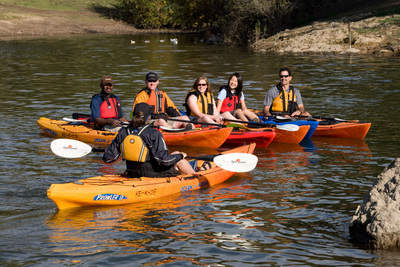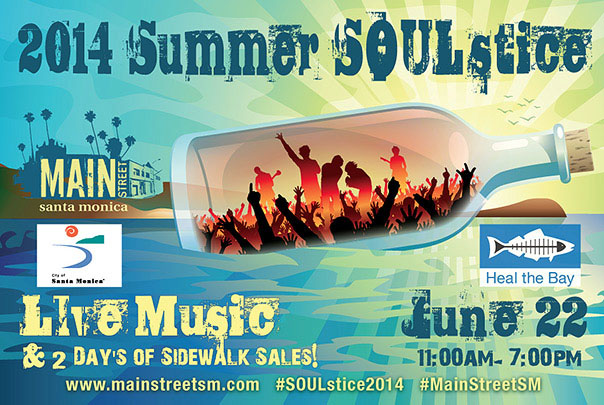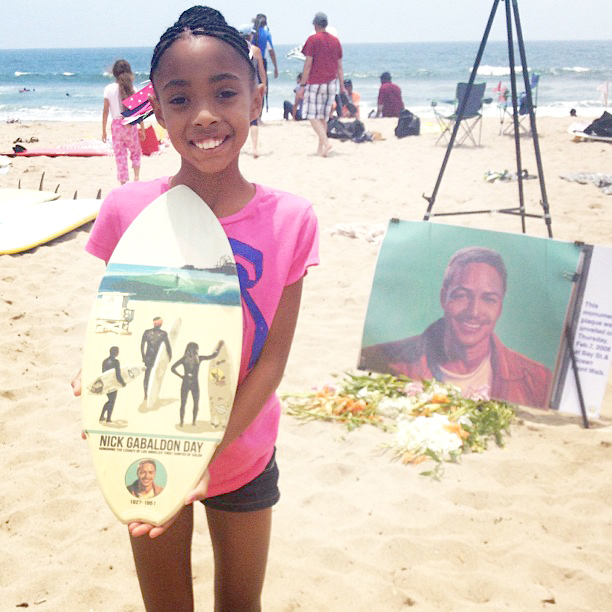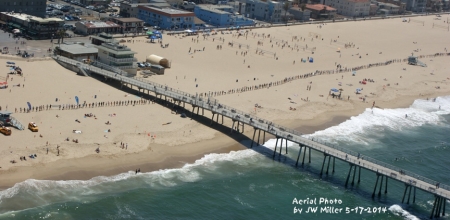Kirsten James, our Science and Policy Director for Water Quality, heralds the arrival of the second and final phase of the City of Los Angeles’ ban on plastic bags.
July 1 marks an important milestone for Heal the Bay and our entire region – the end of the single-use plastic bag in the city of Los Angeles! With phase 2 of the ban soon to be implemented, we are now the biggest city in the nation to successfully tackle the economic and environmental scourge of the plastic bag.
Under a ban championed by Heal the Bay and enacted by the City Council, large retailers stopped distributing single-use plastic bags six months ago and started charging 10 cents for recycled paper bags. Now the same requirements kick in for certain small retailers like convenience stores and pharmacies. With an estimated 2 billion single-use plastic bags taken out of circulation each year in the city due to this policy, we can expect to see a lot less blight and waste in our communities and shorelines.
It has been a long road to get us to this spot. Heal the Bay and our partners urged the city, other communities and the state for many years to move forward with bag policies and other measures to reduce plastic pollution. The efforts are now paying off: Some 108 jurisdictions in California have joined the fight and implemented similar policies. SB 270, a bill authored by state Sen. Alex Padilla that takes these requirements statewide, is now poised to be signed into law later this year.
It is reassuring to witness the ease of implementation as cities become more sustainable. The city of Los Angeles and other communities have reported few violations or complaints in the start-up period. The vast majority of consumers realize that it doesn’t take much effort to think beyond wasteful single-use products and remember a reusable bag alternative.
For those who haven’t fully transitioned into reusable mode, remember to start bringing your reusable bags to small stores such as corner drug stores, mom-and-pop groceries and convenience marts like 7-Eleven beginning July 1.
People often ask our policy team, “What’s next for you guys after the bag ban?” Unfortunately, there’s still plenty more to be done to address plastic pollution and single-use products clogging our waste-stream and oceans. Single-use bag policies can act as a gateway to get people thinking more sustainably in other areas of their life, whether it’s skipping plastic water bottles or refusing drinking straws at restaurants. Next up for Heal the Bay is focusing on a strong statewide trash policy. We’ll keep you posted.
In the meantime, start spreading the news about the ban…and maybe put a plastic bag in your scrapbook to show your grandkids.
FAQ via lacitybag.com
When does the ban on plastic carryout bags take effect?
To reduce waste and pollution, on January 1, 2014, the City of Los Angeles will ban plastic carryout bags and require a $0.10 fee on each paper carryout bag requested by the customer at certain large retailers. On July 1, 2014, the City of Los Angeles will ban plastic carryout bags and require a $0.10 fee on each paper carryout bag requested by the customer at certain small retailers.
Are all shapes and sizes of plastic bags banned?
Plastic carryout bags at large and small retail stores affected by the ordinance are banned. Not all plastic bags are banned. Bags allowed are:
- Produce bags used for bagging vegetables, fruits and meats, and pharmacy bags;
- Restaurant bags;
- Hardware stores bags (e.g. Home Depot, Lowes and others); and
- Select retail stores bags (e.g. Macy’s, JC Penny, Ross, TJ Maxx, and others).
Consumers may consider using used bread or chip bags, sandwich bags, liners for cereal boxes, and other types of bags as an alternative for wet waste and pet droppings.
What types of stores are included in the ban?
Large stores with gross annual sales of over $2 million selling dry groceries, canned goods, or nonfood items and perishable items or stores of at least 10,000 square feet of retail space generating sales or use tax and has a licensed pharmacy are included in the ban (e.g. Ralphs, Target, Walmart, Vons, Food 4 Less, 99cent Only Stores, Walgreens, CVS, Rite Aid, and others).
Small stores such as drug stores, pharmacies, supermarkets, grocery stores, convenience food stores, food-marts, and other entities engaged in the retail sales of a limited line of goods that sell milk, bread, soda, and snack foods, in addition to stores with a Type 20 or 21 license issued by the Department of Alcoholic Beverage Control are included in the ban (e.g. 7-Eleven, AM PM Mini Markets, and others).
The City of Los Angeles’ program is similar to the ordinances adopted by a number of local jurisdictions including the cities of Long Beach, Pasadena, and Manhattan Beach as well as the unincorporated areas of Los Angeles County.
Where can I get reusable bags?
ON JULY 1 ONLY: Visit these locations in LA for a free bag, while supplies last!
Reusable bags are widely available for purchase at select retail stores and markets. Reusable bags are also being distributed by LA Sanitation through select City-sponsored events and locations on a first come, first served basis and provided at no cost while supplies last.
For Retailers
How would my store comply with the Single-Use Carryout Bag Ordinance?
- Cease providing customers single-use plastic carryout bags (produce bags or product bags are exempt).
- Make available to customers reusable carryout bags or recyclable paper carryout bags.
- Charge customers requesting recyclable paper carryout bags 10 cents per bag (No store shall rebate or otherwise reimburse customers for any or all of the 10-cent charge required).
- Provide at the point of sale, free of charge, either reusable bags or recyclable paper carryout bags or both, at your option, to any customer participating either in the Electronic Benefits Transfer (EBT), Special Supplemental Food Program for Women, Infants, and Children (WIC) or in the CalFresh/Supplemental Nutrition Assistance Program (SNAP) for purchased items covered under those programs. Items not covered under these programs e.g. beer, wine, liquor, etc. will not require stores to provide free of charge, either reusable bags or recyclable paper carryout bags to carry these items.
- Indicate the number of recyclable paper carryout bags provided and the total amount charged for the bags on customer receipts.
- Complete and submit Quarterly Report Form online at http://san.lacity.org/ no later than 30 days after the end of each quarter.
What information will be included in the Store Quarterly Report?
- Total number of recyclable paper bags provided (including those provided free of charge to EBT, WIC, and/or SNAP customers).
- Total amount collected from the paper bag charge (NOTE: Actual amount collected from the paper bag charge are to be retained by the store).
- Efforts to promote reusable carryout bags, if any.
Are biodegradable plastic bags allowed?
No. Plastic carryout bag means any bag made predominantly of plastic derived from either petroleum or a biologically-based source, such as corn or other plant sources. It includes compostable and biodegradable bags.
Can biodegradable plastic bags at least 2.25 mils thick be considered “reusable”?
Yes, as long as the requirements of a Reusable Bag as defined in the Ordinance are met.
Will there be a charge for small sized paper bags distributed at checkout, typically provided by small stores to their customers?
Yes. Any store that provides a recyclable paper carryout bag at checkout to a customer must charge the customer 10¢ for each bag provided to carry out their purchase.
Which bags should I charge 10¢ for?
You must charge 10¢ for each paper bag provided to a customer for the purpose of carrying purchased goods away from your store. Carryout bags provided to WIC/SNAP purchases are exempt from this charge.
Are prescription bags subject to the 10-cent charge?
According to the California Pharmacy Board, pharmacies are required to keep medical information confidential. Since many pharmacies use opaque bags for this purpose, only carryout bags used for prescription drugs would be exempt from the Bag Ordinance. Carryout bags customers obtain for other purchased items would still be affected.
Is there a law that requires me to put alcoholic beverages into carryout bags?
The California Department of Alcoholic Beverage Control has no law that mandates a retailer provide a bag for purchased alcoholic beverages. If a paper bag is provided, you must apply the 10¢ charge.
What is the 10-cent charge used for?
All monies collected by a store under this Ordinance will be retained by the store and may be used for:
- Costs associated with compliance
- Actual costs of providing recyclable paper carryout bags
- Costs associated with a store’s educational materials or education campaign encouraging the use of reusable bags including “Remember Your Bag” signage in parking lots.
Does the 10-cent charge per paper bag apply to everyone? Who is exempt?
All affected stores authorized to accept EBT, WIC, or SNAP purchase payments must provide at the point of sale, free of charge, either reusable bags or recyclable paper carryout bags or both, at the store’s option, to any customer participating either in the EBT, WIC, or SNAP for purchased items covered under those programs. Items not covered under these programs e.g. beer, wine, liquor, etc. will not require stores to provide free of charge, either reusable bags or recyclable paper carryout bags to carry these items.
Is the 10-cent charge per paper bag taxable?
No, according to the State Board of Equalization 10-cent charge on recyclable paper carryout bags would not be subject to State sales tax.
Are reusable bags less than 15 L in volume capacity allowed to be given away for small stores that typically sell items smaller in size and quantity to individual customers?
No. Customers are to be reminded to bring back their reusable bags when shopping. If only a small number of items are being purchased or the items being purchased have handles, customers can easily carry away without a bag.
Who is responsible for enforcement of the ordinance?
Bureau of Sanitation of Department of Public Works, City of Los Angeles will be responsible for enforcement of the Ordinance.
What are the penalties and fines for Ordinance violations?
- Written warning notice
- Fine not exceeding one hundred dollars ($100.00) for the first violation after a written warning notice given
- Fine not exceeding two hundred dollars ($200.00) for the second violation after a written warning
- Fine not exceeding five hundred dollars ($500.00) for the third and any subsequent violations after a written warning
What happens to the money collected from violation fines?
Fines collected pursuant to this Chapter shall be deposited in the Citywide Recycling Trust Fund of the Bureau of Sanitation, Department of Public Works to assist with costs of implementing and enforcing the Ordinance.
Can written warnings and fines be disputed or appealed?
A store operator who receives a written warning notice or fine may request an administrative review of any fine issued by filing a written notice of appeal with the Director of Bureau of Sanitation no later than 30 days after receipt of a written warning notice or fine.
The notice of appeal must include all facts supporting the appeal and any statements and evidence, including copies of all written documentation and a list of any witnesses that the appellant wishes to be considered.
A hearing officer will conduct a hearing concerning the appeal within 45 days from the date that the notice of appeal is filed, or on a later date if agreed upon by the appellant and the Bureau of Sanitation, and will give the appellant 10 days prior written notice of the date of the hearing.
The hearing officer may sustain, rescind, or modify the written warning notice or fine, as applicable, by written decision. The hearing officer will have the power to waive any portion of the fine in a manner consistent with the decision. The decision of the hearing officer is final and effective on the date of service of the written decision, is not subject to further administrative review, and constitutes the final administrative decision.
Have any cities in California banned single-use plastic bags?
As of October 1, 2013, over 55 cities and counties have banned single-use plastic carryout bags in California including Glendale, Long Beach, Malibu, Pasadena, San Francisco, San Jose, Santa Monica, West Hollywood, and unincorporated areas of Los Angeles County.
Can customers use their own carryout bag?
Yes. Anything they can safely carry their groceries with, including: reusable bags, baskets, buckets, and boxes.
What if customers don’t want to buy/bring a reusable bag or purchase a paper bag?
If they can comfortably carry their paid purchases out by hand, that is one option; or their goods can be packaged back into the shopping cart or basket for transporting to their vehicle, where they can be unloaded.
Are reusable bags recyclable? Where can customers bring them to be recycled?
Depending on the material, it may be recyclable. Visit Earth911.com for more information on recycling locations.
Who do I contact for questions about the Single-Use Carryout Bag Ordinance?
For questions, please contact the City of Los Angeles, Solid Resources Citywide Recycling Division by email at SRCRD@lacity.org or call (213) 485-2260.
Is there a law that requires that alcoholic beverages be placed in carryout bags?
There is no California law that mandates a retailer provide a bag for purchased alcoholic beverages. If a paper bag is provided, a 10¢ charge must be applied.







